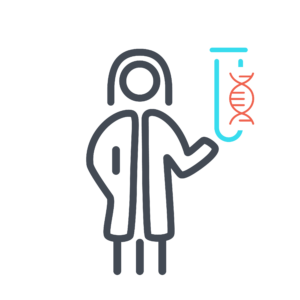Xq28 Duplication Syndrome

Table of contents
- What is Xq28 duplication syndrome?
- Key Role
- Symptoms
- What causes Xq28 duplication syndrome?
- Why do I or my child have Xq28 duplication syndrome?
- What are the chances that other family members or future children will have Xq28 duplication syndrome?
- How many people have Xq28 duplication syndrome?
- Do people who have Xq28 duplication syndrome look different?
- How is Xq28 duplication syndrome treated?
- Behavior and development concerns linked to Xq28 duplication syndrome
- Males with Xq28 duplication syndrome
- Females with Xq28 duplication syndrome
- Where can I find support and resources?
- Sources and References
What is Xq28 duplication syndrome?
Xq28 duplication syndrome happens when a person has an extra piece of the X chromosome, one of the body’s 46 chromosomes. Chromosomes are structures in our cells that house our genes. The extra piece can affect learning and how the body develops.

Key Role
Genes within the Xq28 region are important for brain development and function.
Symptoms
Because the Xq28 region is important for brain activity, many people who have Xq28 duplication syndrome have:
- Intellectual disability
- Aggression and irritability
- Attention-deficit/hyperactivity disorder (ADHD)
- Autism
- Anxiety
- Difficulty sleeping, insomnia
- Recurring ear infections
- Asthma
- Obesity
What causes Xq28 duplication syndrome?
Xq28 duplication syndrome is a genetic condition, which means that it is caused by variants in genes. Our genes contain the instructions, or code, that tell our cells how to grow, develop, and work. Genes are arranged in structures in our cells called chromosomes. Chromosomes and genes usually come in pairs, with one copy from the mother, from the egg, and one copy from the father, from the sperm.
We each have 23 pairs of chromosomes. One pair, called the X and Y chromosomes, differs between biological males and biological females. Biological females have two copies of the X chromosome and all its genes, one inherited from their mother and one inherited from their father. Biological males have one copy of the X chromosome and all its genes,inherited from their mother, and one copy of the Y chromosome and its genes, inherited from their father.
In most cases, parents pass on exact copies of the gene to their child. But the process of making the sperm and egg is not perfect. A variant in the genetic code can lead to physical issues, developmental issues, or both.
The Xq28 gene is located on the X chromosome, so variants in this gene can affect biological males and biological females in different ways. Biological males who have variants in this gene will likely have Xq28 duplication syndrome.
Biological females who have variants in this gene may or may not have symptoms of Xq28 duplication syndrome. Biological females who have one working copy of the gene and one non-working copy are considered to be ‘carriers’. Even if a biological female does not have signs or symptoms of the syndrome, they can pass it along to their children.
X-linked recessive conditions
Research shows that Xq28 duplication syndrome is often the result of an inherited variant in Xq28. This means that Xq28 duplication syndrome happens because the genetic variant was passed down from a biological female parent. Biological females that carry the Xq28 variant usually do not have symptoms, but sometimes they might.
Sometimes it results from a spontaneous variant in the Xq28 gene in the sperm or egg during development. When a brand new genetic variant happens in the genetic code is called a ‘de novo’ genetic variant. The child can be the first in the family to have the gene variant.
X-Linked Recessive Genetic Syndrome
Why do I or my child have Xq28 duplication syndrome?
No parent causes their child’s Xq28 duplication syndrome. We know this because no parent has any control over the chromosome changes that they do or do not pass on to their children. Please keep in mind that nothing a parent does before or during the pregnancy causes this to happen. The genetic change takes place on its own and cannot be predicted or stopped.
What are the chances that other family members or future children will have Xq28 duplication syndrome?
Each family is different. A geneticist or genetic counselor can give you advice on the chance that this will happen again in your family.
The risk of having another child who has Xq28 duplication syndrome depends on the genes of both biological parents.
- Biological females who have a variant in the Xq28 gene and are pregnant with a daughter have a 50 percent chance of passing on the same genetic variant and a 50 percent chance of passing on the working copy of the gene.
- If they are pregnant with a son, the child has a 50 percent chance of inheriting the genetic variant and the syndrome.
For a symptom-free brother or sister of someone who has Xq28 duplication syndrome, the sibling’s risk of having a child who has Xq28 duplication syndrome depends on the sibling’s genes and their parents’ genes.
- If neither parent has the same genetic variant causing Xq28 duplication syndrome, the symptom-free sibling has a nearly 0 percent chance of having a child who would inherit Xq28 duplication syndrome.
- If the biological mother has the same genetic variant causing Xq28 duplication syndrome, and the symptom-free daughter has the variant, the symptom-free daughter’s chance of having a son who has Xq28 duplication syndrome is 50 percent.
For a person who has Xq28 duplication syndrome, the risk of having a child who has the syndrome is about 50 percent.

How many people have Xq28 duplication syndrome?
As of 2025, about 82 people with Xq28 duplication syndrome, and more than 600 people with MECP2 duplication syndrome, have been described in medical research.

Do people who have Xq28 duplication syndrome look different?
People with Xq28 duplication syndrome may look different. Appearance can vary and can include some but not all of these features:
- Long forehead
- Thick and wide lower lip
- Large ears

How is Xq28 duplication syndrome treated?
Scientists and doctors have only just begun to study Xq28 duplication syndrome. At this point, there are no medicines designed to treat the syndrome. A genetic diagnosis can help people decide on the best way to track the condition and manage therapies. Doctors can refer people to specialists for:
- Physical exams and brain studies
- Genetics consults
- Development and behavior studies
- Other issues, as needed
A developmental pediatrician, neurologist, or psychologist can follow progress over time and can help:
- Suggest the right therapies. This can include physical, occupational, speech, or behavioral therapy.
- Guide individualized education plans (IEPs).
Specialists advise that therapies for Xq28 duplication syndrome should begin as early as possible, ideally before a child begins school.
If seizures happen, consult a neurologist. There are many types of seizures, and not all types are easy to spot. To learn more, you can refer to resources such as the Epilepsy Foundation’s website: epilepsy.com/…t-is-epilepsy/seizure-types

This section includes a summary of information from major published articles and the Simons Searchlight quarterly registry report. It highlights how many people have different symptoms. To learn more about the articles, see the Sources and References section of this guide.
Behavior and development concerns linked to Xq28 duplication syndrome
The duplicated Xq28 region differs from person to person. Research suggests that there are 3 different regions that are commonly duplicated in the Xq28 region: 1) a region that includes the MECP2 and IRAK1 genes, 2) a region that includes the GDI1 and IKBKG genes, and 3) a region that includes the RAB39B, CLIC2, FUNDC2, CMC4, MTCP1, BRCC3, VBP1, and F8 genes.
The information below includes people from all three categories.
Males may inherit the Xq28 duplication from a mother who may or may not have medical features. Usually, the X chromosome carrying the variant undergoes selective X inactivation. This is a random process where a cell chooses one X chromosome to silence gene expression. If the affected X chromosome is inactivated, this means that the Xq28 duplication would be silenced or turned off. For some females, the unaffected X chromosome is inactivated, resulting in a person having more medical features.
Males with Xq28 duplication syndrome
Learning
Most males with Xq28 duplication syndrome had developmental delay or intellectual disability (ID), usually mild to moderate.
- 21 out of 24 people had developmental delay or intellectual disability (88 percent)
Behavior
Males with Xq28 duplication syndrome had behavioral issues, such as autism, attention-deficit/hyperactivity disorder (ADHD), anxiety, aggression and irritability, and self-injury behavior.
- 6 out of 23 people had autism (26 percent)
- 6 out of 19 people had ADHD (32 percent)
- 3 out of 21 people had anxiety (14 percent)
- 6 out of 19 people had aggression and irritability (32 percent)
- 1 out of 19 people had self-injury behavior (5 percent)

Graphs
100%
80%
60%
40%
20%
0
Brain
Some males with Xq28 duplication syndrome had neurological medical issues, such as a smaller than average head size (microcephaly), a mood disorder (depression or bipolar), and schizophrenia.
- 1 out of 19 people had microcephaly (5 percent)
- 2 out of 19 people had a mood disorder (11 percent)
- 1 out of 19 people had schizophrenia (5 percent)

Growth
Some males with Xq28 duplication syndrome had obesity and were much taller than average.
- 5 out of 19 people had obesity (26 percent)
- 3 out of 19 people were taller than average (16 percent)
Infections
Most males with Xq28 duplication syndrome had recurrent infections, such as ear infections, pneumonia, and upper respiratory tract infections.

Females with Xq28 duplication syndrome
Learning
One-half of females with Xq28 duplication syndrome had developmental delay or intellectual disability (ID), usually mild or not apparent.
- 8 out of 16 people had developmental delay or intellectual disability (50 percent)
Behavior
Some females with Xq28 duplication syndrome had behavioral issues, such as autism, attention-deficit/hyperactivity disorder (ADHD), and anxiety.
- 3 out of 19 people had autism (16 percent)
- 3 out of 16 people had ADHD (19 percent)
- 2 out of 16 people had anxiety (13 percent)

Graphs
100%
80%
60%
40%
20%
0
Brain
Some females with Xq28 duplication syndrome had neurological medical issues, such as a smaller than average head size (microcephaly) or a mood disorder (depression or bipolar).
- 1 out of 16 people had microcephaly (6 percent)
- 1 out of 16 people had a mood disorder (6 percent)
Growth
Rarely, females with Xq28 duplication syndrome had obesity.
- 1 out of 16 people had obesity (6 percent)

Where can I find support and resources?
Simons Searchlight
Simons Searchlight is an online international research program, building an ever growing natural history database, biorepository, and resource network of over 175 rare genetic neurodevelopmental disorders. By joining their community and sharing your experiences, you contribute to a growing database used by scientists worldwide to advance the understanding of your genetic condition. Through online surveys and optional blood sample collection, they gather valuable information to improve lives and drive scientific progress. Families like yours are the key to making meaningful progress. To register for Simons Searchlight, go to the Simons Searchlight website at www.simonssearchlight.org and click “Join Us.”
- Learn more about Simons Searchlight: www.simonssearchlight.org/frequently-asked-questions
- Simons Searchlight webpage with more information on Xq28 duplication: www.simonssearchlight.org/research/what-we-study/xq28-duplication
- Simons Searchlight Facebook group: https://www.facebook.com/groups/xq28-duplication

Sources and References
- Abdala, B. B., Gonçalves, A. P., Dos Santos, J. M., Boy, R., de Carvalho, C. M. B., Grochowski, C. M., Krepischi, A. C. V., Rosenberg, C., Gusmão, L., … & Santos-Rebouças, C. B. (2021). Molecular and clinical insights into complex genomic rearrangements related to MECP2 duplication syndrome. European Journal of Medical Genetics, 64(12), 104367. doi:10.1016/j.ejmg.2021.104367
- Ballout, R. A., El-Hattab, A. W., Schaaf, C.P., & Cheung, S. W. Xq28 duplication syndrome, Int22h1/Int22h2 mediated. 2021 Feb 25. In: Adam MP, Feldman J, Mirzaa GM, et al., editors. GeneReviews® [Internet]. Seattle (WA): University of Washington, Seattle; 1993-2025. Available from: https://www.ncbi.nlm.nih.gov/books/NBK349624/
- Levy, M., Elron, E., Shohat, M., Lifshitz, S., Kahana, S., Shani, H., Grossman, A., Amar, S., Narkis, G., … & Maya, I. (2024). Exploring inheritance, and clinical penetrance of distal Xq28 duplication syndrome: Insights from 47 new unpublished cases. Journal of Human Genetics, 69(7), 337-343. doi:10.1038/s10038-024-01252-7
- Pascual-Alonso, A., Martínez-Monseny, A. F., Xiol, C., & Armstrong, J. (2021). MECP2-related disorders in males. International Journal of Molecular Sciences, 22(17), 9610. doi:10.3390/ijms22179610
